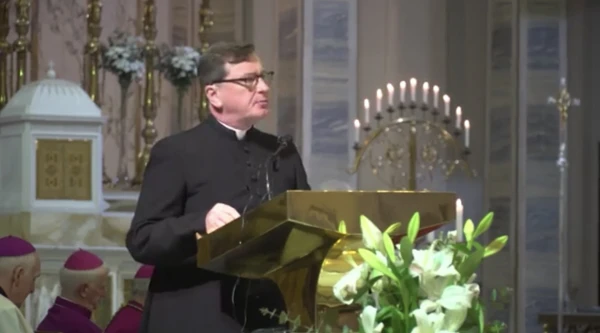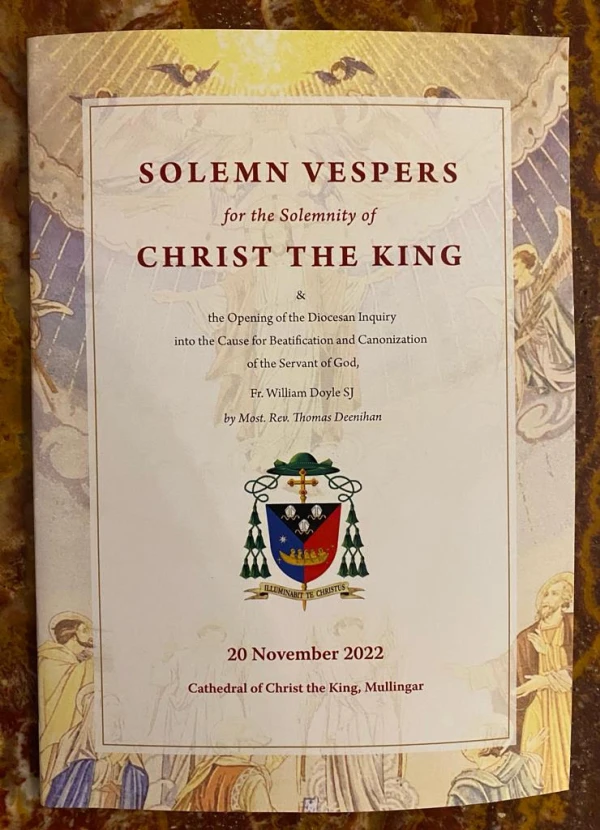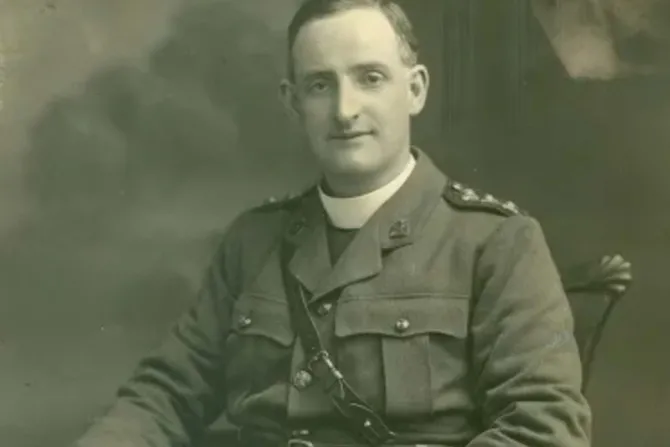Father Willie Doyle, S.J.
Last weekend, the cause for the canonization of Jesuit Father Willie Doyle was opened. An inspiring — yet unassuming — Irish World War I chaplain, he was killed in 1917 at Passchendaele, Belgium, during the Third Battle of Ypres. His body was never recovered. He was known for his compassion for everyone, irrespective of nationality or religion.
As a Protestant officer wrote in his diary: “Father Doyle never rests. Night and day, he is with us. He finds a dying or dead man, does all, comes back smiling, makes a little cross and goes out to bury him, and then begins all over again.”
The ceremony on 20 November at the Cathedral of Christ the King, Mullingar, Ireland, was presided over by Bishop Thomas Deenihan of Meath.

Doyle’s cause was introduced by Father John Hogan, diocesan postulator, who detailed Doyle’s remarkable spiritual life and his self-sacrifice in helping others on Flanders Fields in 1917. Nine other bishops and many priests attended the Mullingar Cathedral ceremony.
Recent films about the First World War offer today’s generation a harrowing cinematic reconstruction, if one is needed, of the conditions Father Doyle confronted and experienced on the front lines. A quagmire of blood, death and destruction, maimed bodies, and broken minds, yet within the mayhem, the light of faith and hope was sustained by chaplains like Doyle.
In presenting his cause, Father Hogan pointed to Doyle’s many virtues as a priest.
“William is a model example and spiritual mentor for those suffering from mental health issues due to his own experience and recovery from a psychological breakdown in his earlier years. His inspiring desire to offer his life — and even his death — as a reparation for the sins of priests can resonate with the Church in these times, as is his love and service of German soldiers as a chaplain.”
Doyle volunteered to serve in the British Army upon the outbreak of the Great War. This was not uncommon: In “Goodbye to All That,” war poet Robert Graves hailed the contribution of the Irish chaplains on the front lines. At that time in Ireland, many among the Catholic population were conflicted as to whether they should join the British Army.
For Doyle, there was no hesitation. He saw serving men on the front lines as part of his vocation to serve souls for life and, through his ministry, to work in reparation for the sins of priests in his pastoral ministry. He was a deeply spiritual man with a profound love for Jesus from a young age. His life and example inspired St. Teresa of Calcutta and St. Josemaría Escrivá, among others.

Father Hogan explained: “In the midst of the horrors of war, he brought consolation, hope, and courage to the men in his care, both Catholic and Protestant, and he was regarded by many as a living saint. He took frequent risks to save men on the battlefield and in administering the sacrament of the dying.“
An obituary in the Ulster Presbyterian Weekly News recognized Doyle’s dedication to souls: “If he risked his life looking after Ulster Protestant soldiers once, he did it a hundred times in the last few days … The Ulstermen felt his loss more keenly than anybody, and none were readier to show their marks of respect to the dead hero priest than were our Ulster Presbyterians.”
Bravery under fire
Irish filmmaker Campbell Miller produced an EWTN docudrama of Father Doyle’s life titled “Bravery Under Fire.”
“I got to know and understand Father Willie Doyle very well over time working on ‘Bravery Under Fire,’” he said. “His selflessness and humanity were astonishing. All denominations loved him and knew that he looked out for them in their darkest and most terrifying moments; even if they were in no man’s land and left for dead, Father Willie would go out for them.”
“He did this time and time again. He would drag the soldier back, lie beside them, and give them the last rites,” the filmmaker said.
“Father Willie always wanted to give soldiers who died a dignified Christian burial, yet this simple mercy could not be awarded to him because his comrades never actually found his body.”
Spiritual warfare
Years of spiritual penance and self-mortification prepared the priest physically and spiritually for the brutal and inhumane conditions he encountered and described: “The first part of our journey lay through a narrow trench, the floor of which consisted of deep thick mud, and the bodies of dead men trodden under foot. It was horrible beyond description.”
His account of saying Mass for the dead in the trenches is harrowing yet compelling: “Round about me on every side was the biggest congregation I ever had: behind the altar, on either side, and in front, row after row, sometimes crowding one upon the other, but all quiet and silent, as if they were straining their ears to catch every syllable of that tremendous act of sacrifice — but every man was dead! Some had lain there for a week and were foul and horrible to look at, with faces black and green.”

A bridge-builder
In formally opening Father Doyle’s case, Bishop Deenihan described him as a “bridge-builder” as defined by Pope Francis and as a man whose generosity extended beyond nationality.
“His desire to offer his life, penance and even his death as a reparation for the sins of priests can resonate with the Church in these times. His love and service of German soldiers offers the Church an example of universal charity. Father Willie can be seen as a servant of peace and reconciliation and a model of true ecumenism. In many ways, his life and witness are more relevant to us now than they were 100 years ago.”
For many faithful, there is a poignancy that to this day, Doyle lies with his men among the fallen, eternally one of the unknown. Yet he is not unknown, but one whose grace and love is known and has consoled and inspired so many.
Source: CNA

